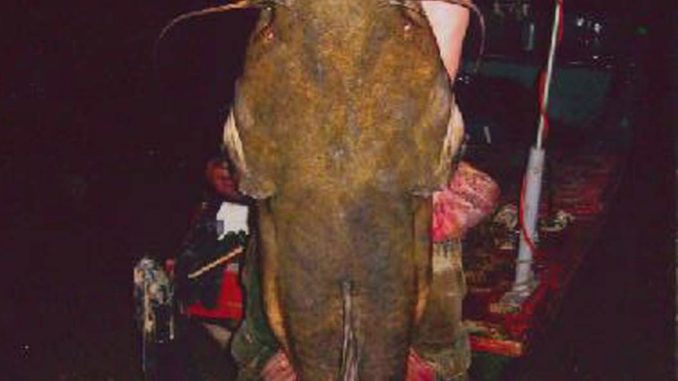
After-dark summer fishing trips can be very productive
Want to beat the heat this summer and have a chance to catch a potential record fish? First, load a skiff with plenty of lighting equipment for after-dark fishing, a couple of cinder-block anchors, eight or nine heavy baitcasting outfits spooled with 50-pound monofilmament, some Carolina and Santee rigs and about 30 eating-sized bluegills in the livewell, plus insect repellant. Then trailer it to the Neuse River in Wayne, Lenoir or Craven counties where the giant flathead catfish live.
The state-record flathead weighed 78 pounds and was caught nine years ago by Brian Newberger from the Cape Fear River. But Michael Paxinos, a 28-year-old wildlife officer with the N.C. Wildlife Resources Commission, and his 53-year-old fishing buddy, Clinton Bardner, believe any summer night that a state-record flathead may swallow one of the bream they’re soaking on the bottom of the Neuse River.
“I got a new good depth finder and tested it out Saturday morning at a place I fish for big catfish,” Paxinos said. “It was amazing; I saw things I’d only guessed were on the bottom.”
One of those things was what he called “a submarine.”
“I don’t know exactly how long it was because I haven’t learned how to gauge that, but it was big around as a man’s chest or a log about 18 inches in diameter,” he said. “That would have put it easily in the 60-pound range and possibly more.”
Anyone who wants to fish for giant flatheads in the Tarheel State would be hard pressed to find a better place than the Neuse River, which has 275 miles of stream entirely inside North Carolina’s borders.
“I’ve been fishing the river for big catfish for 12 years,” said Paxinos, a Goldsboro native and Kinston resident. “My biggest weighed 57 ½ pounds, but I know there are bigger ones in the river.”
A typical night might include five or six flatheads from 25 to 50 pounds, but Paxinos has caught more between dusk and dawn.
“But sometimes you don’t get bit at all,” he said.
Several tactics help Paxinos and Bardner.
“You got to catch your bream from the same water where you fish for flatheads,” Paxinos said. “If you get bream from a pond, they won’t react the same way in a strange body of water, like the Neuse, as they would in a pond.”
Another key to successful flathead fishing is knowledge of where they hang out and patience.
“You have to fish for where they’re living,” he said. “That takes knowing where their bedrooms and kitchens are.”
Bedrooms may include deep holes, undercut banks, big rocks or at submerged logjams.
“Deeper water usually is at the outside of channel bends,” Paxinos said.
And flatheads aren’t daylight feeders, as a rule.
“They like to leave their bedrooms and go where Ronnie Powell (a legendary Neuse River catfish angler) calls their ‘kitchens’ – where bream live,” he said. “It’s a lot like deer hunting — we try to ambush ’em between beddin’ and feedin’ areas. The bite might not happen for hours, but at some point, it’ll turn on — if you’re at the right place.”
Flatheads prefer live bait, while blue cats, which also live in the Neuse, like cut bait.“We catch most of our blue cats at sand bars,” Paxinos said.

